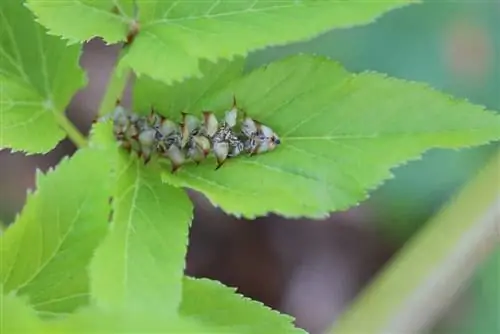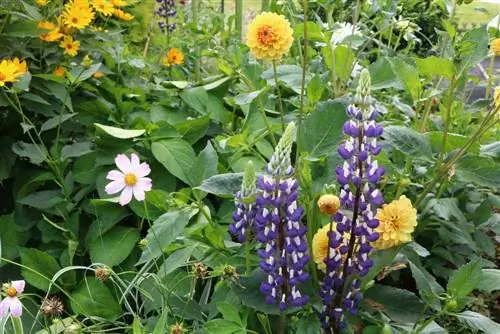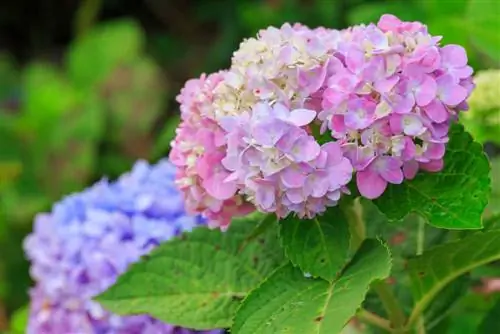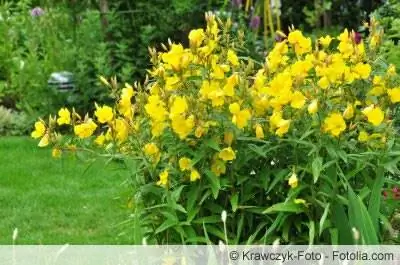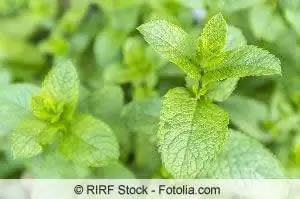- Author admin [email protected].
- Public 2023-12-17 03:39.
- Last modified 2025-06-01 06:48.
Angelica grows very large. There is rarely room for more than two to three plants in a normally proportioned herb garden. But cultivation is definitely worthwhile. Angelica not only has an aromatic smell and taste, it can also be used as a medicinal plant. The plant is said to have a bilious and antispasmodic effect. It is therefore often used for gastrointestinal complaints. Teas or tinctures are usually used, including for rheumatism, gout or nicotine or alcohol poisoning.
Attention - risk of confusion
There is a risk of confusion with the deadly poisonous water hemlock. In addition, the plant is often confused with giant hogweed, which is also not harmless. The surest distinguishing feature of hogweed is the flowers. In angelica they are spherical and green in color, while in giant hogweed they are plate-shaped and white. The water hemlock can be recognized by its unpleasant smell and by its red-spotted stem at the bottom.
Short profile of angelica
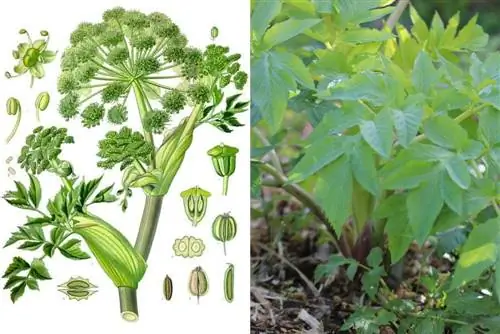
Also called real or medicinal angelica
- Umbelliferous family
- Used in folk medicine
- Thrives in Northern and Eastern Europe, in Central Europe in moist locations
- Two to four-year-old plant that only flowers once
- Summer green
- 1 to 3 m high
- Has a thick rhizome
- In the 1st year almost only the roots and a few leaves form
- Upright stems, petioles round and hollow
- Double umbellate inflorescences from June to August
- Greenish white to yellowish petals
- Small pale yellow split fruits
Angelica Care
Angelica originally grows in moist meadows, on the banks of rivers and lakes. The plant also needs similar conditions in the garden. It is only partially suitable for the balcony because it gets very large. In addition, the plants have very long roots, so they require a very high pot with appropriate space at the bottom. Angelica is also cultivated for commercial commercial use. A suitable location and a suitable planting substrate are crucial for thriving. This should never be too dry. A high nutrient content is also beneficial.
Site conditions
Angelica likes sunny to semi-shady places in the garden that should not be too dry. The plants can even cope with shade, but they don't develop enough aroma because they need sun. It is important to have a location protected from the wind, simply so that the long stems do not break. If possible, give angelica the wettest spot in the garden. It can even cope with permanently moist soils. In order to thrive, angelica needs a lot of space. This must be taken into account when planting. Plants growing up to 2, 50 and taller are unsuitable as underplanting.
- Sunny to partially shaded
- Protected from the wind
- Neither too dry, nor constantly wet
The plants like wet, temporarily flooded, nutrient-rich clay soil. It is important that the substrate is not too dry. It has to be very fine. Stones in the ground are rather unfavorable. It is important that there are not a lot of weeds. The soil should not be freshly fertilized!
- Moist, nutrient-rich, humus-rich, deep soils
- Weed-free soil
- Not rocky
- Very fine substrate
- No dry, light soils
- No waterlogging
Planting angelica
Good soil preparation is important when planting. All weeds must be removed, the soil hoeed and raked; it must be finely crumbly but well settled. There are two ways angelica can be cultivated. Either you sow directly outdoors or you prefer young plants and then plant them out. Planting is ideally done in mid-April or late August. It is ideal to plan around 1 m² of space per plant. This way they can develop optimally. Their visual effect is also very good; they are impressive plants.
- Row spacing 50 cm
- Planting distance 25 to 30 cm
- Plan around 1 m² per plant
The care is not very demanding. It is important, especially at the beginning, to keep the soil loose and remove weeds. In addition, the soil must always be moist. The plants do not suffer from drought at all. Moderation is important when fertilizing. In addition, support is recommended for many plants so that the tall stems do not bend or even break. The best thing to start with is to get one or two young plants and plant them in the garden. If they feel comfortable under the existing conditions, they bloom and then continue to produce new plants through self-sowing. Overwintering angelica does not cause any problems. The plants are extremely frost-resistant.
Pouring
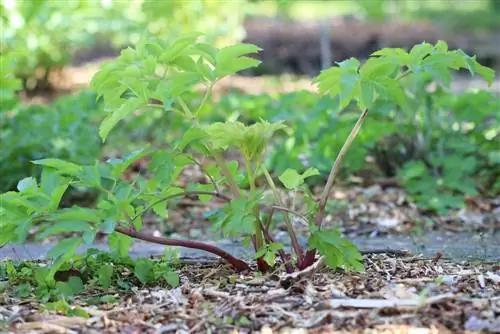
Water is important for angelica plants. If the location itself is not moist enough, a lot of watering needs to be done. The plants cannot tolerate drought. Lack of water is indicated by limp, drooping leaves. If this happens rarely, it's not a problem. With regularity, lack of water weakens the plants and they often suffer and die.
- Moist Earth
- Water abundantly
- Don’t let the soil dry out
- Do not water on the leaves
Fertilize
It is ideal to mix compost into the soil when planting. This can also be repeated every spring. Since the nutrient requirement is high, horn meal should also be added about 3 times. Other organic fertilizers are also suitable. Although mineral fertilizers are also permitted for commercial cultivation, this is less recommended, especially if angelica is to be used as a medicinal plant.
- Mix in compost
- Use organic fertilizers
- Refertilize about 3 times
Cutting
You don't actually have to cut, but it is recommended if you want to achieve a strong rootstock. To do this, the flower buds should be reduced. There is also a trick to prevent the plant from dying after flowering. You simply cut off all the flower heads before seeds form. The plant then produces new side shoots and lasts significantly longer. In addition, of course, cutting is done for harvesting.
- Cutting to strengthen rhizomes.
- Reduce flower roots
- Prevent dieback after flowering
- Cut off flower heads before seeds form
- Cut for harvest
- If you don't want to sow yourself, you have to cut off the flower heads before the seeds are ripe.
Propagation - sowing
The seeds of angelica do not last long. If you cannot sow immediately after harvesting, you should store them in the refrigerator. Otherwise, sowing outdoors works best because natural conditions prevail there. This also saves you having to do some complicated stratification.
- Sowing in early autumn
- Cold germination
- Don’t sow too deep
- Keep the soil moist, but never wet
- Remove the weakest plants after germination so that the stronger ones have more strength
- Next year, space plants apart, at least 50 cm apart
Diseases and pests
Diseases and pests are very rare. Angelica is a robust and he althy plant, at least if the location and planting substrate are right and sufficient water is available. Nevertheless, diseases or pests can occur. Aphids are quite common. But they can be easily removed. They are simply rinsed with a sharp jet of water.
Aphids - rinse off
Harvesting and Use of Angelica
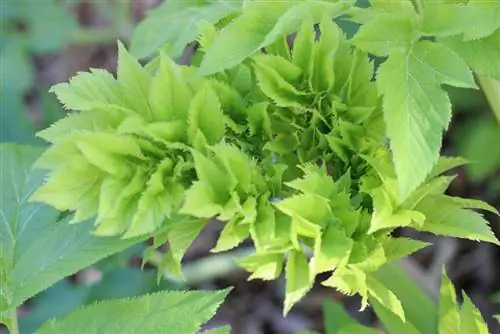
Leaves, petioles, stems and seeds can be used. The roots are also particularly interesting. They are dug up in the fall and then cleaned and dried until they become brittle. The best time to harvest the root is late September to mid-October and then in dry weather. Harvested this way, the oil content is highest. If necessary, it can also be harvested around mid-March, before budding. Leaves and petioles can be used in soups, salads and sauces. They have a delicately spicy taste. However, the leaves also make a delicious vegetable. The stems can be eaten raw and taste pleasantly fruity. Seeds and roots are used to make liqueurs.
The leaves are most nutritious in May and June, the fruits from June to August. The root is harvested in autumn.
Conclusion
Angelica is a very versatile plant, you can eat large parts of it, use it as a medicinal plant and it is a great structure-forming solitary plant for the herb garden. You can't expect much more from a garden plant. Although angelica is rather short-lived, it ensures its own reproduction. When the mother plant dies, there are usually plenty of seedlings soon. The continued existence is therefore assured. They just need to be isolated. Angelica is very easy to care for if the location is right and the soil is always slightly moist. Drought and lean, light soils are not good for the plants. Otherwise, care is child's play.

